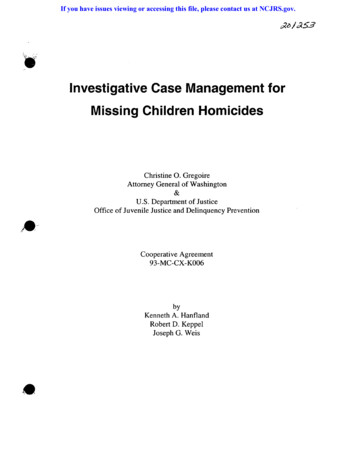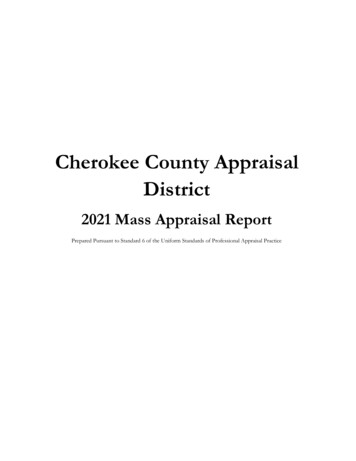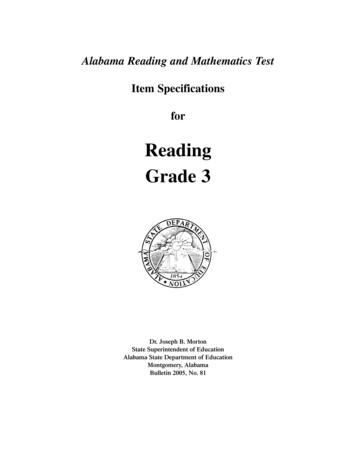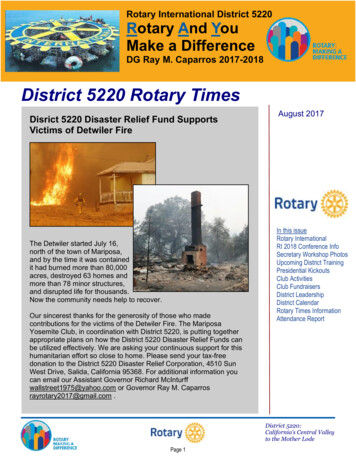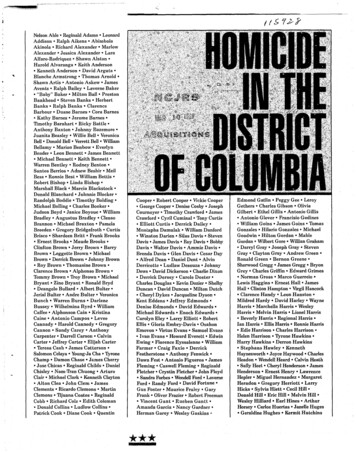
Transcription
Nelson Able· Reginald Adams LeonardAddison· Ralph Aikens' AbimbolaAkinola Richard Alexander· MarlowAlexander Jessica Alexander· LaraAlfaro-Rodriquez· Shawn Alston·Harold Alvaranga Keith Anderson Kenneth Anderson· David Arguta Blanche Armstrong· Thomas Arnold·Shawn Artis· Antonio Askew· JamesAvents Ralph Bailey· Laverne Baker "Baby" Baker· Milton BaIl· PrestonBankhead· Steven Banks· HerbertBanks· Ralph Banks· ClarenceBarbour· Duane Barnes· Cora Barnes Kathy Barnes· Jerome Barnes·Timothy Barnhart· Ricky Battle·Anthony Baxton Johnny Bazemore·Juanita Beasley· Willie Bell· VeronicaBell Donald Bell Verrett Bell WilliamBeIlamy Marion Benbow· EverlynBendel'· Leon Bennett· James Bennett Michael Bennett· Keith Bennett·Warren Bentley· Rodney Benton·Santos Berrios· Adnew Beshir· MeilBess· Ronnie Best· William Bettis·Robert Bishop· Linda Bishop·MarshaIl Black· Marcia Blackstock·Donald Blanchard· Johnnie Blocker·Randolph Boddie· Timothy Bolding·Michael Bolling· Charles Booker·Judson Boyd· Janice Boyoue· WilliamBradley· Augustus Bradley· ClensoBrannon· Michael Braxton· PamelaBreeden· Gregory Bridgefroth CurtisBrisco· Shardeen Britt· Frank Brooks Ernest Brooks' !daude Brooks·Clinfton Brown· Jerry Brown· BarryBrown Leggette Brown· MichaelBrown· Derrick Brown' Johnny Brown Roy Brown· Thomasine Brown·Clarence Brown· Alphonso Brown·Tommy Brown· Troy Brown· MichaelBryant· Zino Bryant· Ronald Bryd Deangelo Bullard· Albert Bulter Jerial Bulter Andre BuIter· VeronicaBunch· Warren Burns· DarleneBussey· Wilhelmina Byrd· WilliamCaffee· Alphonson Cain· KristinaCaine· Antonio Campos· LeveeCannady Harold Cannedy· GregoryCannon· Sandy Carey· AnthonyCarpenter' Darrell Carson· CalvinCarter· Jeffrey Carter· Elijah Carter Teresa Cash· James Catterson·Salomon Celaya· Young-Ja Cha 'JYroneChamp. Damon Chase· James Cherry Jose Chic as Reginald Childs· DanielChisley Nam-Tran Chuong· ArtumClair· Michael Clark· Kenneth Clayton Alton Clea John Clem· JamesClements· Ricardo Clemons' MartinClemons· Tijuana Coates· ReginaldCobb· Richard Cole· Edith Coleman Donald Collins· Ludlow Collins·Patrick Cook· Diane Cook· QuentinCooper· Robert Cooper· Vickie Cooper George Cooper· Denise Cosby· JosephCournoyer· Timothy Crawford· JamesCrawford· Cyril Cuminal Tony Curtis Elliott Curtis' Derrick Dailey·Muscapha Damulal, William Danford Winston Darien· Silas Davis· StevenDavis· James Davis· Roy Davis· BobbyDavis· Walter Davis· Ammie Davis·Brenda Davis· Glen Davis· Cesar Day Alfred Dean· Daniel Dent· AlvinDerricotte· Ludlaw Desouza· JohnnyDews· David Dickerson· Charlie Dbwn Derrick Dorsey· Carole Doster·Charles Douglas· Y.evin Dozier ShelbyDuncan· David Duncan' Milton Dutch Cheryl Dykes· Jacqueline Dyson.Kent Eddens Jeffrey Edmonds·Denise Edmonds· David Edwards·Michael Edwards· Enoch Edwards·Carolyn Eley Larry Elliott· RobertEllis' Gloria Embry-Davis· OsahonEmovon Virtus Evans· Samuel Evans Ivan Evans· Howard Everett· EdwinEwing· Florence Eyssalenne WilliamFarmer Craig Faxio DerrickFeatherstone· Anthony Fenwick·Dawn Fest· Antonio Figueroa· JamesFleming· Caswell Fleming· RegiilaldFletcher' Crystin Fletcher' John Floyd Sandra Forbes· Wendell Ford· LaverneFord. Randy Ford· David Fortune·Gus Foster· Maurice Fraley· GaryFrank· Oliver Frazier· Robert Freeman Vincent Gant Rueben Gantt·Amanda Garcia· Nancy Gardner·Herman Garey· Wesley Gaskins"***Edmond Gatlin· Peggy Gee· LeroyGethers· Charles Gibson OliviaGilbert· Ethel Gillis· Antonio Gillis Antonio Glover' Francisio Godines William Goins· James Goins· TomasGonzales· Hilario Gonzales· MichaelGoodwin· Hilton Gordan· MableGordan· Wilbert Gore' Willian Graham Darryl Gray· Joseph Gray· StevenGray· Clayton Gray. Andrew Green·Ronald Green Bernon Greene·Sherwood Gregg· James Gregg· BryonGrey· Charles Griffin Edward Grimes Norman Gross· Marco Guerreio Lewis Haggins· Ernest Hall· JamesHall Clinton Hampton Virgil Hancock Clarence Handy· Leon Hanston·Mildred Hardy. David Harley· WayneHarris· Marchella Harris WesleyHarris· Melvin Harris· Lionel Harris Beverly Harris Regional Harris·Ian Harris Ellis Harris· Ronnie Harris Edie Harrison· Charles Harrison·Helen Harrison· 'JYrone Hawkins·Harry Hawkins· Derron Hawkins Stephans Hawley· KennethHaynesworth· Joyce Haywood CharlesHeadon Wendell Heard Calvin Heath Sally Heet· Cheryl Henderson· JamesHenderson· Ernest Henry· LawrenceHepler· Miguel Hernandez· MargaretHerndon· Gregory Herriott LarryHicks· Sylvia Hiett· Cecil Hill Donald Hill Eric Hill Melvin Hill Wesley Hilliard· Earl Hines· ArthurHorsey Carlos Huertas' Janelle Huges Geraldine Hughes· Kermit Hutchins
CoverThe cover alphabetically listsall victims of homicide in theDistrict from January 1985through June 1988. ;. . ,".{?',,''"j,
115928U.S. Department of JusticeNational Institute of JusticeThis document has been reproduced exactl)' as received from theperson or organization originating it. Points of view or opinions statedin this document are those of the authors and do not necessarilyrepresent the official position or policies of the National Institute ofJustice.Permission to reproduce this copyrighted material has beengranted byDistrict of Columbia/Office-ofCriminal Justice Plans & Analysisto the National Criminal Justice Reference Service (NCJRS).Furtner reproduction outside of the NCJRS system requires permission of the copyright owner.LmER FROM THE MAYORLmER FROM THE DIRECTORINTRODUCTIONTERMS AND DEFINITIONSNATIONAL OVERVIEWTHE VICTIMTHE ASSAILANTPATTERNS OF HOMICIDEHOMICIDE AMONG BLACKSPREVENTING HOMICIDE'wDISCUSSIONREVIEW OF FINDINGSAPPENDIX"
--------------------------1111Each human life is a precious one Wemust protect the precious lives of thosewe love, and protect the precious livesof our communities. While we recognizethe seriousness of the homicide problemin the District, let us not becometolerant of this violence and senselesskilling, or hopeless in our efforts tochange this situation.Marion Barry Jr.Mayor'f,fY ,' his report provides informationand insight about one of the most devastating crimes and social problems,homicide. The social implications of thiscrime are immense as both the causesand effects tend to threaten the stabilityof families, communities and populationgroups.While homicide is the most intenseand harmful expression of violence, it isalso a symptom of the despair and bleakoutlook for the future that so many ofour citizens feeL Based on informationcontained in the report, this general disillusionment affects both victims andassailants, many of whom are involvedin illegal drug use or sales. Commissionof a homicide is often the ultimateexpression of violence by someone whoselife has been characterized by abuse,crime, poverty, poor self-esteem. and lackof identification with a sense of familyand kinship The victims often also fitthis same description These dire socialcircumstances are compounded bythe virtual ease with which guns, theweapons used most frequently, may beobtained and brought into our cityThe District of Columbia has one ofthe most stringent gun control laws inthe nation; yet, the lack of compatiblelegislation in neighboring states interferes with our ability to keep handgunsout of the possession of persons who posea risk to public safety While this report'sexamination of patterns of homicidesindicates that most deaths result fromshootings, I must remind you that thesenumbers do not capture the even greaternumber of critical injuries caused by mearms which adds to the serious need tocontrol firearm sales and distribution.However, enforcement is not the onlyanswer. Violence is an insidious diseasethat has permeated our society. Tocombat it, we must do more to changethe attitudes and behavior of all citizens,particularly our youth We must, byexample and through teaching, demonstrate that honesty and compassion forone's fellow man are the true markingsof maturity. We must instill in our youtha sense of pride and commitment to thework ethic. Most of all, we must givethem a sense of hope that a world ofequal opportunity for present andfuture success is available to them.
1I, 7.: omicide in the District ofColu'mbia is a descriptive analysis of thistragic crime over the past three and onehalf years. This devastating crime isexamined from the perspective of thevictim, assailant, locations and patternsof the offenses. This study was undertaken as a result of the increased number of homicides over the past few yearsand as a natural outgrowth of the office'slandmark report entitled, Drug Abuseand Crime in the District of Columbiathat was published in 1987. Our researchin compiling the study on drug abuseforetold a continual rise in homicides ifsignificant abatement of illegal drugactivity did not occur.Unfortunately, the situation withwhich we are confronted today is a growing trend, particularly on the part ofyoung black males, to adopt violence asa symbol of strength and a vehicle foracquiring financial gains through illegaldrug sales. Currently, nearly 60 percentof homicides are thought to be drugrelated.'-Since homicide is a very personaltragedy that involves many factors andaffects many victims, we have providedinformation in addition to statisticalanalyses. The report discusses salientissues such as homicide among blacksand homicide prevention, and offersa case study that depicts the predominant social patterns associated withthis crime.Just as there are multiple victims ofhomicide, there are multiple causes ofviolence and homicide, thus increasingthe need for well-coordinated, comprehensive approaches to dealing with thistragic social phenomenon. The Districtof Columbia's Commission of PublicHealth recently undertook a majorinitiative to mobilize the community, incooperation with other public agencies,to develop strategies aimed at preventingviolence. Other public agencies haveinitiated programs that address thisproblem, such as the development ofcurricula in public schools that incorporate values emphasizing self-respectand respecting other people and theirproperty. Also, several initiatives areunderway aimed at teaching parents howto be more effective at child rearing.In addition to these violence prevention programs, millions of dollars havegone into specialla\'V enforcement andcorrections programs to apprehend andincarcerate persons who commit violentacts. One noteworthy outcolne of thisbroad-based approach for addressingthe problems associated with violenceis that intergovernmental coordinationand communication have been greatlyimproved, strengthening our abilityto develop long-term solutions to themyriad causes of homicide.We expect this report to evoke avariety of emotional reactions from youas it did with us during its preparation:sadness, fear, anger, and sheer outrageat the vulnerability we all feel for ourselves, our families and future generations. If we are to reverse the shockingtrends revealed in this report, we musttranslate those emotions into positiveactions aimed at preventing the useof violence as a method for resolvingconflict.Shirley A. WilsonDirector,OCJPA
·"."n 'fuesday, August 30, 1988,anewspaper reported three tellingaccounts of homicide and violence inthe District of Columbia. These incidents of homicide and violence involvedvery different circumstances and verydifferent victims.A-31-year-old man was arrestedfor the murder of a mentally ill streetwoman in July. His victim, a 45-yearold woman who was homeless formore than 10 years and a resident atan emergency shelter in NorthwestWashington, was known for singingsongs and reading passages from theBible to passersby. She was foundraped, with multiple stab woundsand her own umbrella forced downher throat.A 25-year-old man, known topolice as the leader of a drug gang ina Northeast Washington neighborhood, was arrested for murder forthe second time in one month. He wasapparently involved in an ongoingand intense feud between rival druggroups, of which his two victims wereallegedly members. His first victimwas a 20-year-old man who was shotseveral times and the other was a28-year-old man who was shot fivetimes in the back. As they lay dying,both victims identified the man astheir assailant. r A 14-year-old youth living inSoutheast Washington confrontedthe drug dealers who had moved intohis neighborhood over the past yearand turned it into a drug market. Hetold them to move on and stop sellingdrugs there. This eighth-grader waswarned by the drug dealers, butcontinued to confront them. Hisopposition was met with reprisal.According to witnesses, this youthgot into an altercation with some ofthe drug dealers and was shot by oneof them. He was not killed, but a clearmessage about his interference withthe flow of drug business was sent.These situations are indeed different.Together, however, they help to painta picture of how homicides occur in theDistrict: how anyone can find him-orherself, for a variety of reasons or noreason at all, in a situation that resultsin homicide.Homicide in the District of Columbiaexamines this critical problem in this cityto provide insight through compilationof statistical information and review ofa range of homicide-related issues.Most homicides are unplanned acts;however, if examined collectively, theypresent regular trends and patterns.This study presents a comprehensivereview of homicide in the District ofColumbia by analyzing both victimsand assailants as distinct groups, inrelation to one another, and in relationto the incident.The population for this study includesall homicide victims and persons arrestedfor homicide in the District from January1985 through June 1988. Informationpresented about these groups includesage, gender, race, residence, urinalysisor toxicology test results, and locationof the body or crime.Additionally, this report presentsepidemiological (regarding the causeof death that affects large numbers ofpeople in a locality) information abouthomicides in the District. Included hereare the time of day, week and year; thearea of the city and type of locationwhere homicides occurred; the weapons,methods and motives involved in thecrime; and local, national and international homicide rates.This study also addresses severalimportant issues related to homicide,including drug-related killings andhomicide prevention. Since the District'shomicide victims and assailants are predominantly black, and homicide in theDistrict is predominantly an intra-racialcrime, this study focuses particularattention on the issue of homicideamong blacks.
'ft\.'. . omicide can be considered intwo contexts: as a criminal act andas a cause of death. While homicide hastraditionally been considered a criminaljustice issue, this report also looks atthe problem from a public health perspective and addresses homicide as an issueof crime and victimization.Homicide is defined as the recklessor intentional taking of human life byanother individual and falls into twocategories: criminal and non-criminal.Criminal homicide refers to first andsecond degree murder, voluntary (nonnegligent) and involuntary (negligent)manslaughter. Non-criminal homicideis considered excusable, as in killing inself-defense, and justified, as in homicide performed as a legal duty by a policeofficer or executioner.Homicide is considered first degreemurder when the assailant killed withspecific intent and malice, and after premeditation and deliberation, or whilecommitting or attempting to commitanother felony crime. Second degreemurder occurs when the assailant killedwithout specific intent or with specificintent, but without premeditation ordeliberation. Voluntary and involuntarymanslaughter refer to killing withoutmalice, but involuntary manslaughteris further classified by the absence ofspecific intent to kill, or specific intentto inflict the injury that caused death.The District records, investigates andprocesses vehicular homicide separatelyfrom the types of homicides outlinedabove. Vehicular homicide is referred toas negligent homicide. Technically, theonly factor that distinguishes a negligent homicide from manslaughter is thata vehicle is involved. In some cases, atraffic death is not considered a homicide at all if there is no evidence ofintent, gross negligence, or wanton andwillful disregard of the law. In such acase, the death is considered as a trafficfatality. Negligent homicides are handledby the Traffic Division of the Metropolitan Police Department (MPD) andneither recorded nor investigated by theMPD's Homicide'Branch.
.-- ---------vput thi, "'po,t about homicide in the District into perspective,this section provides an overview ofhomicide in the United States. Currently,homicide nationally comprises 1 percentof violent crime and less than 1 percentof all crime. While homicides in theUnit0d States decreased by 3 percentfron; 1986 to 1987, homicides increasedby 4 p rcent from 1983 to the present.1987 national data about victims of homicide reveal that:74 percent were males49 percent were ages 20 to 3453 percent were white45 percent were blackData about assailants showthat:34 percent were ages 18 to 2446 percent were white52 percent were ta about homicide patternsnationally reveal that:59 percent of homicides resulted fromshootings20 percent resulted from stabbings17 percent of victims were related totheir assailants40 percent of victims were acquaintedwith their assailantsThis report on homicide reveals that,while the District has some homiciderelated problems that may be particularto this city, many of the contributingfactors and characteristics of the victims,assailants and patterns reflect thehomicide problem in the nation.
. "'.J.atters relating to the victim'\are generally regarded more as a publichealth issue than a criminal justice issue.When homicide is discussed from acriminal justice perspective, the focus isprimarily on investigating the criminalact and apprehending the assailant. Apublic health view examines homicideas a disease and seeks to uncover factorsthat will help to understand and preventthis premature and unnatural cause ofdeat.h that affects such large numbers ofpeople in our community. Victim information was gathered from the District'sMetropolitan Police Department andCommission of Public Health.The majority of victimsin the District were young,black males .
AGERACE AND GENDERMost homicide victims who diedbetween January 1985 and June 1988were ages 18 to 32. Thirty (30) percentof the victims were ages 18 to 25 andan additional 24 percent were ages 26to 32. The most frequent age reportedwas 25 years old. Only 7.3 percent ofthe cases were ages 1 to 17, while 18percent were ages 33 to 39, 10 percentwere ages 40 to 47, and another 10v' rcent were over 47 years old. Thisage pattern is consistent across eachyear of the study (Table 1, Figure 1).Most homicide victims were blackmales. Nearly 90 percent of all victimswere blacl{, while 5 percent were whiteand 5 percent were of other races. Mostof the victims, 84 percent, were male. Abreakdown by race and gender indicatesthat approximately 75 percent of thecases were black males, 14 percent wereblack females, 4 percent were white malesand 1 percent were white females. Eachyear in the study shows a similar pattern for both race and gender (Table 2,Figure 2). Table 1Age of VictimsCY 1985 - June 19881985Age1-1213-1718-2526-3233-3940-4747 Total*Median 101011111131*'Ibtals exclude cases for which datais incomplete.Totals include justifiable homicides.111114328716912629Source: Metropolitan Police Department.Prepared By: Office of Criminal JusticePlans and Analysis.Percent totals may not equal 100 dueto rounding.Table 2Race and Gender of VictimsCY 1985-June 19881985Race/GenderBlack MaleBlack FemaleWhite MaleWhite FemaleOther MaleOther 21193381155781253510232730671275145141*Totals exclude cases for which datais incomplete.'Thtals include justifiable homicides.1Percent totals may not equal 100 dueto rounding.82251Source: Metropolitan Police Department.Prepared By: Office of Criminal JusticePlans and Analysis.J
,*ti,,-,.w.,{tk.Aj, 9g"*}!?st.\3?l\\"dWjmlliti:t, .ti'!f t A\w,;ftIi!.*\"'M) ,,,1':;;{i .1"-'t"'i."t"it7Jt!l\1""9"",,".·,::t J,. .J. ;r.:'-' \.f";'{'i:\' ,';!:;:wr,'I;-Ill -:r !:".o:'· .:;o i?"··-'·{'(:;;-!;"-·-·-"'''''''':''-'';-·'': ,1"""'." ",. ";-.,, -.,., , '. · ',,:.,o.-,-.,", "''''"' ".".c-. ,w ." ,.,, " . '" fr,t' j -N'; -- ,- ,3)tJtAtLGI Ji Figure 1Median Ages of Victims/Assailants19861985 1987I ; AssailantsVictimsFigure 2Race and Gender of Victims6Race and Gender of Assailants.83%rIrr307 824.2%.97%322.4%4.4%,104.6%41.2%1 3410%14%75% [ il[JDOther FemalesBlack Males Black Females ·White Males White Females Other MalesBlack Males Black Females White Males[J9
RESIDENCESUBSTANCE ABUSEA yearly analysis of victims' residence reveals no consistent homicidepattern. However, collapsing all yearstogether shows that most victims lived inWard 8 (20 percent), Ward 5 (16 percent)and Wards 6 and 7 (15 percent each),and very few victims lived in Ward 3(1 percent) and Ward 4 (8 percent)(Table 3).Toxicology data indicate that about63 percent of the victims had some typeof drug or alcohol in their systems whileonly 32 percent did not. The mostcommon substances found in victimswere PCP, cocaine, and alcohol. Yearlydrug analyses indicate that victimsincreasingly used both PCP and cocaine,while alcohol use decreased over thestudy period. In 1985, 15 percent of thevictims had PCP in their systems, 17percent had cocaine and 37 percent hadalcohol. In 1988, however, 22 percent ofthe victims were found to have PCP, 45percent had cocaine, and 23 percent hadalcohol. Only a small portion of thecases were found to have heroin, marijuana, or other drugs, such as methadoneand amphetamines, in their systems(Table 4, Figure 3).Table 3Residence of VictimsCY 1985-June 18151916*Thtals exclude cases for which 831625202544167101121015121526Percent totals may not equal 100 dueto rounding.is incomplete.Thtals include justifiable al#%746044284798210853314111816151520Source: Metropolitan Police Department.Prepared By: Office of Criminal JusticePlans and Analysis.Table 4Toxicology of VictimsCY 1985-June 0335266242891228537Number ofCases Tested**156* Categories not mutually exclusive.**Totals include justifiable andvehicular homicides.207242Source: Commission of Public Health.Prepared By: Office of Criminal JusticePlans and Analysis.10119724
Figure 3Toxicology of VictimsCY 1985 -J une 1988198519861987--PCP- - - - Cocaine----Heroin---Alcohol---Other----None111988 Marijuana
'(':\ W!'tf}iplV;rr",-';::1.-3",'26%.m .ifo!,,-8;n",,'mtiM:'!k:,R q. '''"S"'#it,P:g;:.§t,,S;J/#,-: . n. ;j!i\Jy?", ,-%!,*.P.d*H'1.Y! :t.s.'P't·'!i"! .t":t;i,,:':. j;;; :,;:" v.··";O" · '! ;"" ';'''V'W;'''· ''''·-'' N''I,'. , . ,o."", , ,· ",. ,,'" ,,.,.,",. -.,,.c-, r,,., ""- -""".,. ,-.--. -,.-0' ; ' .2J , H1I4A\ LALJJf This defendant was arrestedin October for the murderof a man in a nightclub inJuly, 1988.This section seeks to present aprofile of the homicide assailant. Information about the assailant, however,refers to individuals arrested for homicide in the District, and not necessarilypeople who have been convicted forcommitting homicide. Additionally, thenumber of people arrested for homicidewill vary from the number of homicidessince people arrested in a given yearmay have committed the murder in aprevious year and a given assailantmay be responsible for more than onehomicide. There were 103 personsarrested for homicide in 1985, 102 in1986, 131 in1987, and 73 in the first sixmonths of 1988. Assai1,;mt informationwas gathered from the MetropolitanPolice Department and the District'sPretrial Services Agency.12
Table 5AGE The profile of the alleged homicideassailant is similar to that of the homicide victilD:' Most assailants were ages18 to 32 with 34 percent being ages 18to 25 and 31 percent being ages 26 to32. Thirty (30) percent of the assailantswere older than 32, while 8 percent wereunder the age of 18. This age pattern foradults (18 and older) is consistent acrosseach year in the study. The number ofjuvenile (under age 18) assailants hasincreased over the years from 11 in 1985to 10 in only the first six months of1988 (Table 5, Figure 1).RACE AND GENDERAn overwhelming majority of theassailants were black males. Close to96 percent of the assailants were black,2 percent were white, and 2 percent werefrom other races. The data also showthat 89 percent of the assailants weremale. A breakdown by race and genderindicates that approximately 86 percentwere black males, while 10 percent wereblack females. Only 1 percent were whitemales while less than 1 percent werewhite females (Table 6, Figure 2).Age of AssailantsCY 1985 -1987AgeUnder 1818-2526-3233-3940-4748 114Total*Median AgeTotal19871986198529*Totals exclude cases for which datais incomplete.Percent totals may not equal 100 dueto rounding.1114127Source: Pretrial Services Agency.Prepared By: Office of Criminal JusticePlans and Analysis.Table 6Race and Gender of AssailantsCY 1985 -19871985#Race/GenderBlack MaleBlack FemaleWhite MaleWhite FemaleOther MaleOther Female88141000103Total*%85141000*Totals exclude cases for which datais incomplete.Percent totals may not equal 100 dueto rounding.131986#%83112150102811121501987# %117 8979111 12300131Total# %288 8634 1041212800336Source: Pretrial Services Agency.Prepared By: Office of Criminal JusticePlans and Analysis.
RESIDENCEThe distribution of assailant residenceis very similar to that of the victims.The greatest number of assailants livedin Ward 8 (19.4 percent). Many otherassailants, however, lived in Ward 6,(17 percent), Ward 5 (16 percent), Ward 7(15 percent) and Ward 1 (13 percent).Less than 1 percent of the assailantslived in Ward 3 (Table 7).DRUG USEPersons arrested in the District areroutinely tested for drug use. Urinalysistest results indicate that cocaine is themost common drug used by personsarrested for homicide. The data showthat 26 percent of the arrestees testedpositive for cocaine, 11 percent for PCp,and 7 percent for opiates such as heroin.Yearly analysis of this data shows thatPCP use declined among those arrestedfor homicide while cocaine use slightlyincreased. For example, 27 percent ofthose arrested for homicide during 1985tested positive for PCP while only 18percent tested positive in 1987. In 1985,24 percent of the same group tested positive for cocaine while 30 percent did in1987 (Table 8). It should be noted thatthese results reflect drug use only amongthose who were tested; approximately53 percent of homicide arrestees werenot tested.Table 7Residence of AssailantsCY 1985 101776*TotaIs exclude cases for which datais incomplete.Percent totals may not equal 100 dueto rounding.1987#%1161720191719108Total# 0/036 1330 112124943 1646 1741 1553 19275Source: Pretrial Services Agency.Prepared By: Office of Criminal JusticePlans and Analysis.Table 8Assailant Drug Test ResultsCY 1985 -1987PCPCocaineMethadoneOpiatesAmphetaminesNo Drugs1985# %18 2716 24218 128536 551986# %12 2312 23126 111228 531817633Number ofCases Tested**665360Drug**Categories not mutually exclusive.**'IbtaIs exclude cases for whichurinalysis testing was not 54179Source: Pretrial Services Agency.Prepared By: Office of Criminal JusticePlans and Analysis.14
TheCaseofaMurdererjohn is/I, 34-yea,rold,liarlilsomeandsyste1p-. He wasplaced insever l youth .homes andsilrved as(mtencein a fedartwulate black maTi who grew up in'eral pNs.C;:;fprw'r.tohiscurrentcomniit Northwest Washington. He is the last offour children, raisedby a single mother' . 'ment. JoM1- says itwasJdsnJ0t1!er's·whoworhed all hows, as a domestic and.absence {r011i. the home and azack of(it odd jobs tCi support her family. John.' supervis.wn and guidaneeth:atled him at;. has already spent morethan 10 years. an early age to a life of drugs and crime.·in prison ana is currently serving q.life·Johniiked having fnoney arid turned·seTJ-tence and other cbnsecutivi:t terriLS'atto critnebeCa11 eit notonlyyielcled .the Lor(on Correctional Complex for aalot otmoheyquickly, but also rpasrange of felony crimes, one of which isasource of excitemeftt: Supporting a ,firstdegreemurder.·.draghabit,ma ntaiTiingtlieUfestyle' ,. John situationisacommoTJ-one. of a"l/ig spericler '. and Uvingin'the"fast' larif!" led. John from being a street. and illustrates theprofileofaho7fLicideassailant: When he committed the mur"dealer to being a, distributor'for a drug ".der, he waS young, poor, unemployed,wholesakr.Asis o{ten'the case, theundereducated, and invollJed in drugsrelationship between Johnand his drug .and crime. He grew upini:L badneighbor7dealers turn!Zdbad. Johnthought lie washood (:Znd got involved with drugs lit agebeing cut out ofthe aCtion withoutbeillg10 and crime at age 12. He started with' .paid for his work. His dealers thought.marijuaTJ-a,moved OTJ- to harder drugs'John was cheating:them. Theywerfl.in·and evelltually graduated to sellingconflict fora period of time,
Dews· David Dickerson· Charlie Dbwn Derrick Dorsey· Carole Doster· Charles Douglas· Y.evin Dozier Shelby Duncan· David Duncan' Milton Dutch Cheryl Dykes· Jacqueline Dyson. Kent Eddens Jeffrey Edmonds· Denise Edmonds· David Edwards· Michael Edwards· Enoch Edwards· Carolyn Eley Larry Elliott· Robert
